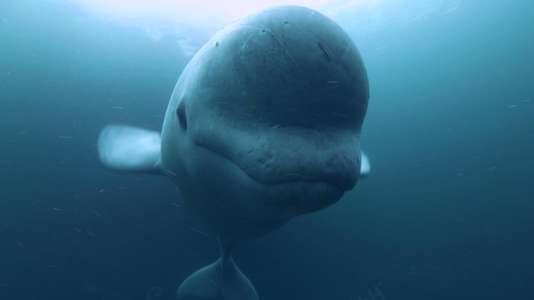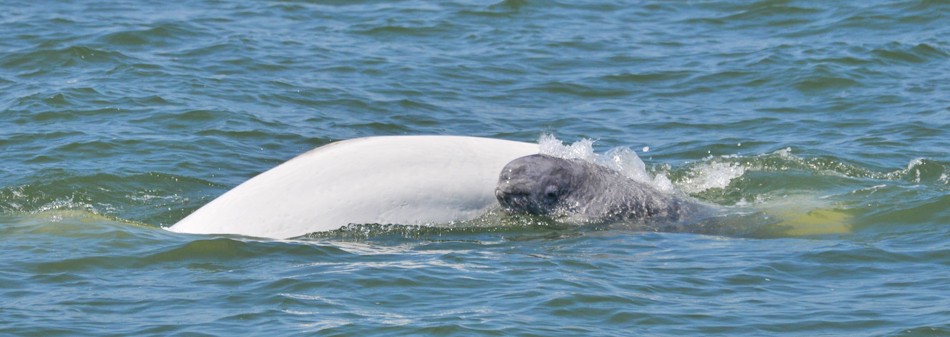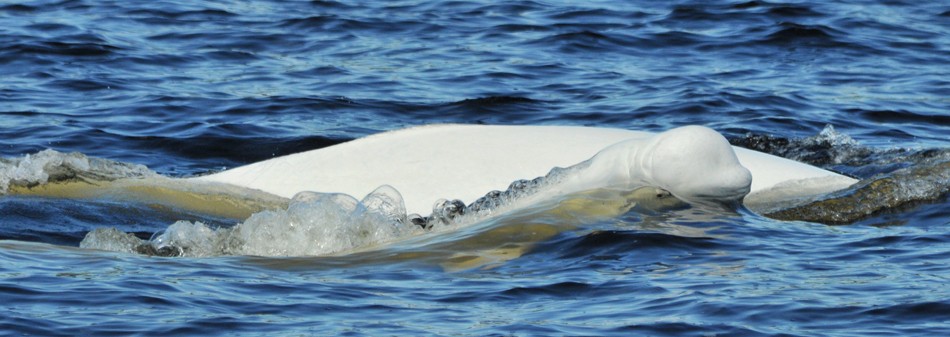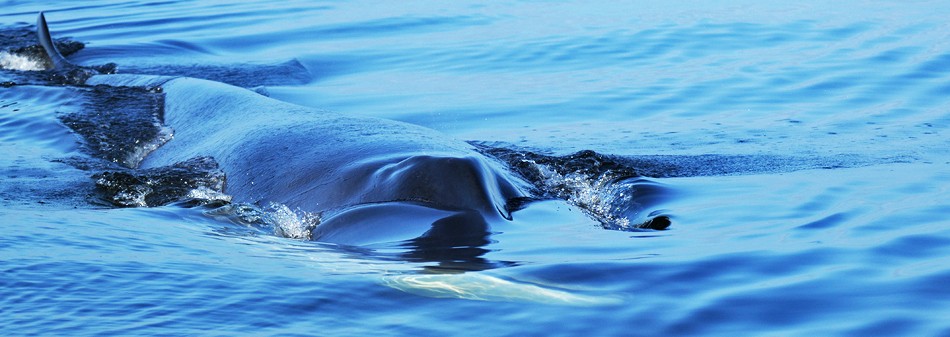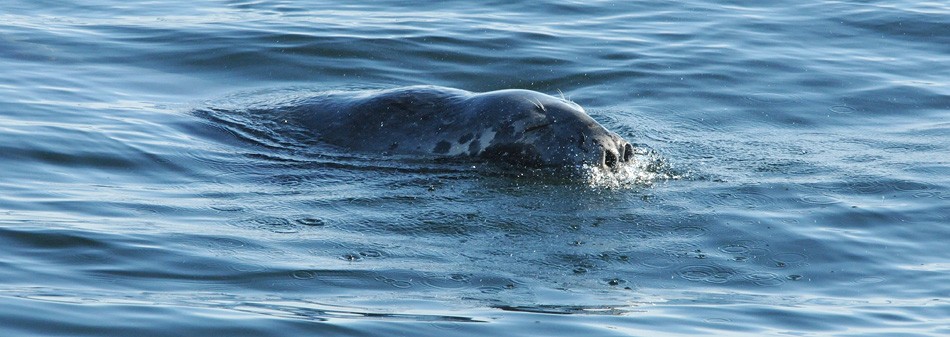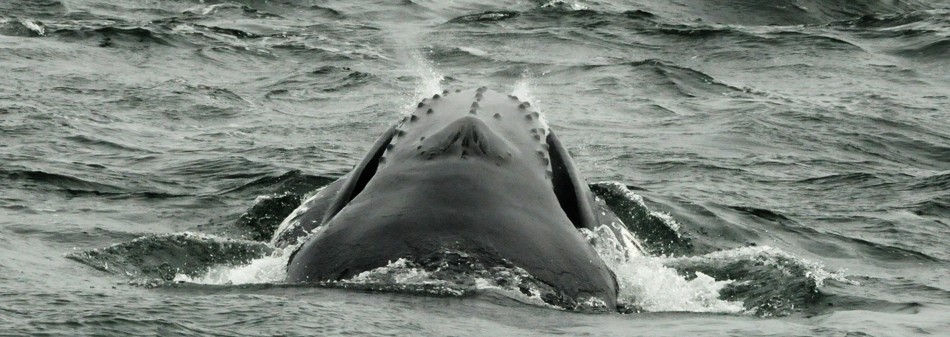04/12/2015
What do Belugas Teach Us about the St. Lawrence and about Ourselves? (8/8)

Beluga stories: this is the final episode of the transcript of the training lecture given by Robert Michaud at the CIMM on June 22, 2015. In this text and audio episode: the genetic diversity of the population and the possibility of an introduction of belugas from the Arctic are discussed at length. A closer look is taken at plans to install an oil platform in the Gulf of St. Lawrence. And what can be done to aid the belugas’ cause?
On June 22, Robert Michaud, scientific director and co-founder of the Group for Research and Education on Marine Mammals (GREMM), gave a training lecture at the Marine Mammal Interpretation Centre (CIMM) in Tadoussac. The biologist and St. Lawrence beluga specialist shared stories about these whales and raised questions about the current decline in the St. Lawrence population. Whales Online brings you excerpts of this presentation, in the form of a sort of written and audio series to be followed all summer and fall.
What critical threshold would have to be reached by the St. Lawrence beluga population to consider relocating belugas from the Arctic? At what number of individuals is the critical threshold of genetic diversity reached?
Robert Michaud fields the question and Nadia Ménard, ecologist and team leader for the Saguenay–St. Lawrence Marine Park, adds some of her own thoughts. The project to reintroduce the Atlantic walrus, which is extirpated in the St. Lawrence, is discussed. Would introducing or reintroducing a population or species cause problems?
Listen (4 min 15 s) (in French)

The Atlantic walrus (Odebenus rosmarus rosmarus), the St. Lawrence population of which is extirpated. (Photo: Ansgar Walk/Creative Commons)
What has become of plans to drill for hydrocarbons in the Gulf of St. Lawrence, notably the Old Harry geological structure?
Listen (3 min 15 s) (in French)
What can be done to maintain the St. Lawrence beluga population? How can stress agents that endanger the population be limited? What’s happening with the project to create a Marine Protected Area (MPA) in the St. Lawrence Estuary?
Listen (4 min 59 s) (in French)
To learn more
On the Fisheries and Oceans Canada website:
The Atlantic walrus
St. Lawrence Estuary Area of Interest
On Whales Online:
How Far Back Does the Presence of Belugas in the St. Lawrence Go?
About the beluga (data sheet)
Previous episodes of the training lecture:
Episode 1
Episode 2
Episode 3
Episode 4
Episode 5
Episode 6
Episode 7
25/11/2015
Belugas on the Move
Video Clip Presenting the Project: Stunning Footage
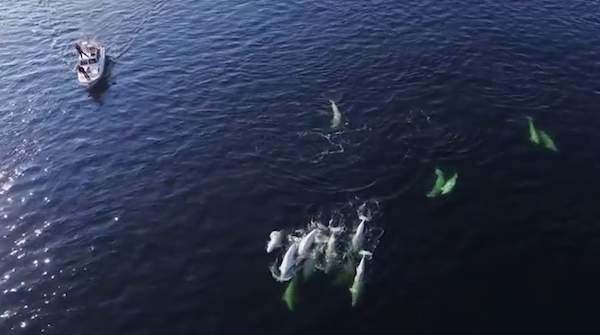
At the dawn of the beluga seasonal migration, one question remains: where will they winter? This is the question that Belugas on the Move attempts to answer. To follow the researchers in their work, check out the regularly updated “Topic of the Hour”.
This project and how it has unfolded to date are presented in this video clip by Yannick Rose © Productions Novo Media 2014; amazing images of belugas and researchers in action!
20/11/2015
What do Belugas Teach Us about the St. Lawrence and about Ourselves? (7/8)

Beluga stories: this is the seventh episode of the transcript of the training lecture given by Robert Michaud at the CIMM on June 22, 2015. In this text and audio episode: the biologist answers questions from the audience who wishes to know more about newborn beluga mortalities.
On June 22, Robert Michaud, scientific director and co-founder of the Group for Research and Education on Marine Mammals (GREMM), gave a training lecture at the Marine Mammal Interpretation Centre (CIMM) in Tadoussac. The biologist and St. Lawrence beluga specialist shared stories about these whales and raised questions about the current decline in the St. Lawrence population. Whales Online brings you excerpts of this presentation, in the form of a sort of written and audio series to be followed all summer and fall.
With regard to newborn belugas found alive on the river banks, do we have a theory that might explain their strandings? Are the young being plagued by some problem? Could the mothers be suffering from dystocia (calving difficulties)?
Listen (1 min 28 s) (in French)
Nadia Ménard, ecologist and team leader for the Saguenay–St. Lawrence Marine Park, adds some food for thought, especially concerning the role of new contaminants in the St. Lawrence (PBDE, chemicals used in the manufacture of fire retardants). The 2008 red tide is also mentioned. In conclusion, is some specific situation responsible for these deaths, or is it a combination of factors?
Listen (2 min 40 s) (in French)
Did the food resources available to females play a role in the newborn mortalities? Herring – a top quality resource for belugas – is discussed. And what role was played by the presence or absence of sea ice in the Gulf of St. Lawrence during the winter?
Listen (4 min 12 s) (in French)
Does the peak of newborn mortalities correspond to a peak in births? Do we know the survival rate of newborns?
Listen (3 min 26 s) (in French)
To learn more
On Whales Online:
Is the accumulation of flame retardants in St. Lawrence belugas cause for concern?
Previous episodes of the training lecture:
Episode 1
Episode 2
Episode 3
Episode 4
Episode 5
Episode 6
30/10/2015
What do Belugas Teach Us about the St. Lawrence and about Ourselves? (6/8)
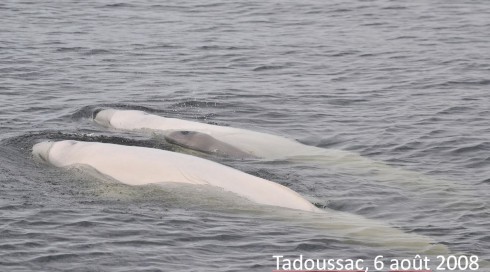
Beluga stories: this is the sixth episode of the transcript of the training lecture given by Robert Michaud at the CIMM on June 22, 2015. In this text and audio episode: beluga fishing of yesteryear with weirs and the film Of Whales, the Moon and Men; the birth of a beluga in captivity and its mother’s behaviour; lending nature a hand by attempting to reintroduce a baby beluga found on shore into a group.
On June 22, Robert Michaud, scientific director and co-founder of the Group for Research and Education on Marine Mammals (GREMM), gave a training lecture at the Marine Mammal Interpretation Centre (CIMM) in Tadoussac. The biologist and St. Lawrence beluga specialist shared stories about these whales and raised questions about the current decline in the St. Lawrence population.
Whales Online brings you excerpts of this presentation, in the form of a sort of written and audio series to be followed all summer and fall. In the final episode (8/8) of News from Near and Afar, Robert Michaud will answer additional questions. What about you, do you have any questions regarding belugas? We urge you to ask them in the “Questions from the Public” section of the website or on the Whales Online Facebook page.
Robert Michaud speaks about the film Of Whales, the Moon and Men, produced by Pierre Perreault and Michel Brault in 1962. At the time, belugas were referred to as “porpoises”. For this film, residents of Île aux Coudres revive traditional “porpoise” fishing using weirs, a practice that disappeared in the 1920s. For what purpose?
Listen (in French) (9 min 04 s)
Photos: © GREMM
In June 2008, a beluga at the Vancouver Aquarium gave birth. The behaviour of this young mother raises many questions. And now, two months later, a baby beluga whale is stranded alive on the north shore of the St. Lawrence Estuary. It was decided to place it back into the water in the hope that it would be adopted by a group of belugas. The monitoring of this attempt yields exceptional observations. But once again, this type of incident raises ethical questions, especially when it is an endangered species: should we let nature follow its course or should we intervene?
Listen (in French) (7 min 44 s)
Photo: © Vancouver Aquarium
Photo: © GREMM
To learn more
On the National Film Board website:
Of Whales, the Moon and Men (downloadable film)
On YouTube:
Qila gives birth in 2010 in the Vancouver Aquarium
On Whales Online:
About the beluga (data sheet)
Previous episodes of the training lecture:
20/10/2015
With the Belugas: Week of September 21, 2015
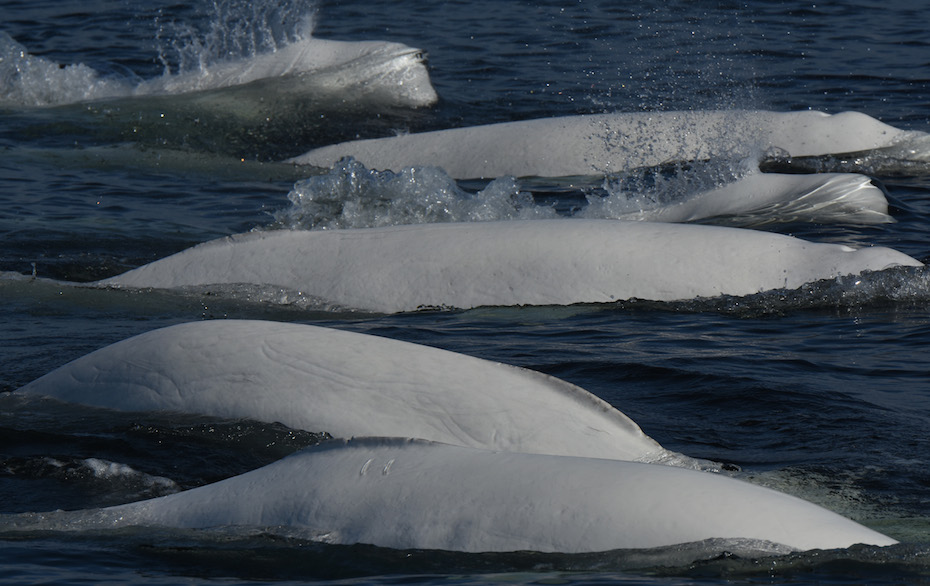
Mission accomplished!
It’s the third and last week of the intensive biopsy program for St. Lawrence belugas. Our goal is to obtain 50 biopsies in each of the three years of the project. We begin the week with 28 biopsies in hand! It’s a tall order!
September 25, 2015: As of the morning of the last day in the field, we have already managed 51 biopsies! The week has been very productive. Just as we’ve done every morning for the past three weeks, we get up early and head out to sea to locate belugas. The more samples we obtain, the higher the likelihood that our results will be representative of the population. Today, we head upstream, into the Upper Estuary. A first contact is made near Île aux Fraises, a second one at Île aux Lièvres and to finish the grand tour, a final one off of Île Blanche off the Charlevoix coasts. Fantastic conditions – but especially the fact that the entire team that has been becoming increasingly adept at sampling – allow us to take an additional seven biopsies. It’s our best season since the program was launched in 2013. A great deal of laboratory work now awaits us. To be continued!
Click on the map to navigate with the Bleuvet and discover the highlights of the week! Although this map is only available in French, the image it illustrates goes beyond language.
IDENTIFICATION OF THE WEEK
Céline – adopted in 1997 by Leslie B. Durst;
Trèfle – adopted in 1988 by the Matthew Ralph Kane Foundation;
Nics – adopted in 2014 the riverside municipalities of the St. Lawrence;
Miss Frontenac – adopted in 2008 by Fairmont Le Château Frontenac;
Conferon Connie – adopted in 2000 by Conferon Incorporated;
Pascolio – adopted in 1990 by Tadoussac business owners;
DL0030 – available for collective adoption;
DL0584 – adoption underway by naturalists of the GREMM;
DL1050 – available for adoption;
DL0218 – available for adoption;
DL0212 – available for adoption.
The complete list of identified belugas requires meticulous efforts to match individuals, which will be undertaken after the field season.
 Property of the GREMM and the St. Lawrence National Institute of Ecotoxicology, the Bleuvet is a research boat dedicated to the research program on St. Lawrence belugas. Managed by GREMM scientific director Robert Michaud, the Bleuvet crew is composed of Michel Moisan, Tim Perrero and Simon Moisan.
Property of the GREMM and the St. Lawrence National Institute of Ecotoxicology, the Bleuvet is a research boat dedicated to the research program on St. Lawrence belugas. Managed by GREMM scientific director Robert Michaud, the Bleuvet crew is composed of Michel Moisan, Tim Perrero and Simon Moisan.
12/10/2015
What do Belugas Teach Us about the St. Lawrence and about Ourselves? (5/8)

Beluga stories: this is the fifth episode of the transcript of the training lecture given by Robert Michaud at the CIMM on June 22, 2015. In this text and audio episode: distribution of males, females and young; reproduction; beluga places of residence in the Estuary; population decline; Cacouna oil terminal project.
On June 22, Robert Michaud, scientific director and co-founder of the Group for Research and Education on Marine Mammals (GREMM), gave a training lecture at the Marine Mammal Interpretation Centre (CIMM) in Tadoussac. The biologist and St. Lawrence beluga specialist shared stories about these whales and raised questions about the current decline in the St. Lawrence population.
Whales Online brings you excerpts of this presentation, in the form of a sort of written and audio series to be followed all summer and fall. In the final episode (8/8) of News from Near and Afar, Robert Michaud will answer additional questions. What about you, do you have any questions regarding belugas? We urge you to ask them in the “Questions from the Public” section of the website or on the Whales Online Facebook page.
Where are the females and young found? And the males? The proportion of females available for reproduction. How males go about reproducing.
Listen (in French) (4 min 58 s)
Photos: © GREMM
Transmitters used to track belugas. Preparing maps of beluga places of residence to develop conservation strategies. Defining critical habitat.
Listen (in French) (2 min 39 s)
Photo: © GREMM
TransCanada’s Cacouna oil port project shelved due to years of scientific data and designation of the St. Lawrence beluga population as “endangered”. Population declining since the early 2000s. Newborn mortalities worrisome in 2012. A certain type of mortality in females at the time of calving. Four hypotheses to attempt to explain the causes of these mortalities.
Listen (in French) (5 min 25 s)
Listen (in French) (7 min 29 s)
Do we need to save the belugas? And why? What if we’re successful?
Listen (in French) (0 min 58 s)
To learn more:
On Whales Online:
St. Lawrence Belugas Declining
Projet de port pétrolier à Cacouna: un danger pour les bélugas (presently in French only)
L’habitat essentiel du béluga du Saint-Laurent est à protéger d’urgence (presently in French only)
About the beluga (data sheet)
Robert Michaud bio
Previous episodes of the training lecture:
08/10/2015
With the Belugas: Week of September 14, 2015

Biopsies Made Challenging by the Wind
In this second week of the intensive beluga biopsy program, we have spent 16 hours with these animals. Autumn can be felt in the air: daylight hours are shorter and it is biting cold on the water! Strong southwest winds prevent us from working in the Estuary much of the week and force us to take refuge in the Saguenay Fjord, but on the morning of September 18, conditions are better. Here is a summary of this day.
It is early morning. We decide to try our luck in the Estuary and venture beyond Batture aux Alouettes in Baie-Sainte-Catherine. The conditions are not encouraging, but we try. In addition to the waves, fog limits our visibility, but we look for belugas, we seek … and we find. They are 100 m away from us and we can barely make them out. There are about thirty animals in two tight, dynamic groups.
At 9:22, 20 minutes after the start of the contact, we fire a first shot… missed! The wind has already picked up and changes the trajectory of the bolt. We reload and approach another group. At 9:34, we fire a second time! This time, the biopsy is successful. Everyone on board gets back into their positions. There’s no time to lose: the animals are in tight, directional groups, which is ideal for this kind of work and should be taken advantage of. Another group emerges next to us, everyone is ready, the belugas are a good distance away, another shot! It is 9:36 and here we are now with two successful biopsies in the span of two minutes. Our luck ends there, however: the wind grows stronger and makes us miss the following two shots. We stop the contact with two biopsies under our belt, which isn’t too bad and then, once again, we return to the Saguenay Fjord!
Click on the map to navigate with the Bleuvet and discover the highlights of the week! Although this map is only available in French, the image it illustrates goes beyond language.
IDENTIFICATION OF THE WEEK
Yogi – adopted in 1988 by Bell Canada;
Pure Laine – adopted in 2014 by Cynthia Fish;
DL0030 – available for collective adoption;
Annakpok – adopted in 2014 by Canada Steamship Lines;
Céline – adopted in 1997 by Leslie B. Durst;
Neige – adopted in 2014 by St. Lawrence riverside municipalities;
DL0269 – available for adoption;
DL0248 – available for adoption;
and DL9001 (Néo).
The complete list of identified belugas requires meticulous efforts to match individuals, which will be undertaken after the field season.
 Property of the GREMM and the St. Lawrence National Institute of Ecotoxicology, the Bleuvet is a research boat dedicated to the research program on St. Lawrence belugas. Managed by GREMM scientific director Robert Michaud, the Bleuvet crew is composed of Michel Moisan, Tim Perrero and Simon Moisan.
Property of the GREMM and the St. Lawrence National Institute of Ecotoxicology, the Bleuvet is a research boat dedicated to the research program on St. Lawrence belugas. Managed by GREMM scientific director Robert Michaud, the Bleuvet crew is composed of Michel Moisan, Tim Perrero and Simon Moisan.
06/10/2015
October 13-15, 2015: Symposium on Impact of Human Disturbance on Arctic Marine Mammals
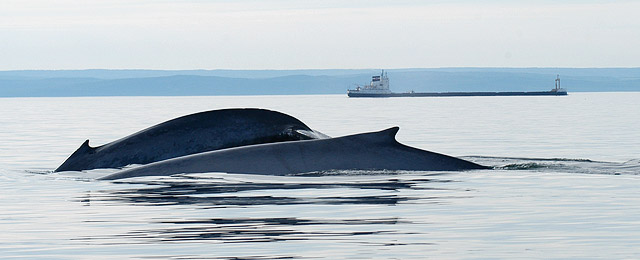
From October 13 to 15, 2015, NAMMCO (The North Atlantic Marine Mammal Commission) is organizing a symposium on the effects of human disturbance – including noise and shipping activities – on the distribution, behaviour and conservation status of marine mammal populations in the Arctic, with a focus on belugas, narwhals and walruses.
This event will be held at the University of Copenhagen in Denmark. Researcher Véronique Lesage of the Ministry of Fisheries and Oceans Canada (DFO) will be amongst the guest specialists and Robert Michaud, president of the Group for Research and Education on Marine Mammals (GREMM), will take part in the discussion tables.
Learn more:
On the NAMMCO website.
02/10/2015
With the Belugas: Week of September 7, 2015

THE MYSTERY OF BAIE SAINTE-MARGUERITE
This week, we take a closer look at the intensive beluga biopsy program spearheaded by researcher Véronique Lesage of Fisheries and Oceans Canada, who will be accompanying us on the water over the next three weeks. We spent 26 hours with belugas and conducted six censuses. On September 11, strong winds from the northeast force us to head up the Saguenay Fjord to Baie Sainte-Marguerite, an enigmatic place where the belugas give us a run for our money.
The day started off well with two biopsies in a herd of about 60 animals in the Île Rouge sector, in the heart of the Estuary, but afterwards weather conditions quickly grew worse. Waves over three feet high make it impossible to work, and we are forced to terminate the contact.
Around 3 pm, after three unsuccessful contacts in which other belugas get away from us among the cresting waves, we end up finding a herd of fifteen animals in Baie Sainte-Marguerite. Here we are sheltered from the wind, but the belugas are the ones making things difficult for us. In this bay, beluga behaviour is often unpredictable, with animals constantly moving in and out of groups and changing direction; in short, they are driving us a bit crazy! This “carousel” is a classic behaviour of Baie Sainte-Marguerite, which is the point of arrival of beluga herds swimming up the Saguenay Fjord. But why do they stop at this spot? Even today, the role that this site plays, though presumably an important one in the lives of belugas, is poorly understood. Is the area a privileged place for feeding? For raising young? Or perhaps to strengthen the social bonds between individuals?
Click on the map to navigate with the Bleuvet and discover the highlights of the week!
IDENTIFICATION OF THE WEEK
Yogi – adopted in 1988 by Bell Canada;
Miss Frontenac – adopted in 2008 by Fairmont Le Château Frontenac;
Pure Laine – adopted in 2014 by Cynthia Fish;
DL0204 – available for adoption;
Dl0030 – available for collective adoption;
Aquabelle – adopted in 2014 by the Aquarium du Québec;
Annakpok – adopted in 2014 by Canada Steamship Lines;
Jetstream – adopted in 2002 by The Fairmont Vancouver Airport;
DL0370 – adopted in 2014 by the Vancouver Aquarium;
Dl0988 – available for adoption;
and Dl2217, Dl9001, Dl9018, Dl1508, Dl1944 and Dl1551.
The complete list of identified belugas requires meticulous efforts to match individuals, which will be undertaken after the field season.
 Property of the GREMM and the St. Lawrence National Institute of Ecotoxicology, the Bleuvet is a research boat dedicated to the research program on St. Lawrence belugas. Managed by GREMM scientific director Robert Michaud, the Bleuvet crew is composed of Michel Moisan, Tim Perrero and Simon Moisan.
Property of the GREMM and the St. Lawrence National Institute of Ecotoxicology, the Bleuvet is a research boat dedicated to the research program on St. Lawrence belugas. Managed by GREMM scientific director Robert Michaud, the Bleuvet crew is composed of Michel Moisan, Tim Perrero and Simon Moisan.
30/09/2015
What do Belugas Teach Us about the St. Lawrence and about Ourselves? (4/8)
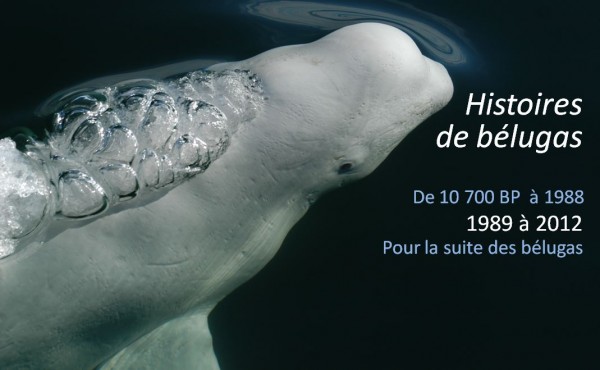
Beluga stories: this is the fourth episode of the transcript of the training lecture given by Robert Michaud at the CIMM on June 22, 2015. In this text and audio episode: the St. Lawrence Beluga Project (research program); contaminants found in the carcasses; when belugas began suffering from cancer.
On June 22, Robert Michaud, scientific director and co-founder of the Group for Research and Education on Marine Mammals (GREMM), gave a training lecture at the Marine Mammal Interpretation Centre (CIMM) in Tadoussac. The biologist and St. Lawrence beluga specialist shared stories about these whales and raised questions about the current decline in the St. Lawrence population.
Whales Online brings you excerpts of this presentation, in the form of a sort of written and audio series to be followed all summer and fall. In the final episode (8/8) of News from Near and Afar, Robert Michaud will answer additional questions. What about you, do you have any questions regarding belugas? We urge you to ask them in the “Questions from the Public” section of the website or on the Whales Online Facebook page.
 St. Lawrence Beluga Project: a research program conducted for the past 25 years to understand and identify solutions for the belugas of the St. Lawrence. The demographics of the population is alarming: if the belugas of the St. Lawrence were healthy, they would be twice as numerous as they are today. Aerial population surveys and carcass recovery program.
St. Lawrence Beluga Project: a research program conducted for the past 25 years to understand and identify solutions for the belugas of the St. Lawrence. The demographics of the population is alarming: if the belugas of the St. Lawrence were healthy, they would be twice as numerous as they are today. Aerial population surveys and carcass recovery program.
Listen (2 min 24 s)
Contaminants found in the carcasses: a long list and abnormally high cancer rates in a wild species.
Listen (1 min 22 s)
Period when belugas were falling victim to cancer: a revealing graph explained. Good news and not so good news on cancer rates and contaminants in the St. Lawrence.
Listen (3 min 22 s)
To learn more:
On Whales Online:
- Research projects: St. Lawrence beluga
- Carcass Recovery Network
- About the beluga (data sheet)
- Robert Michaud bio














